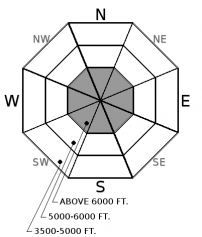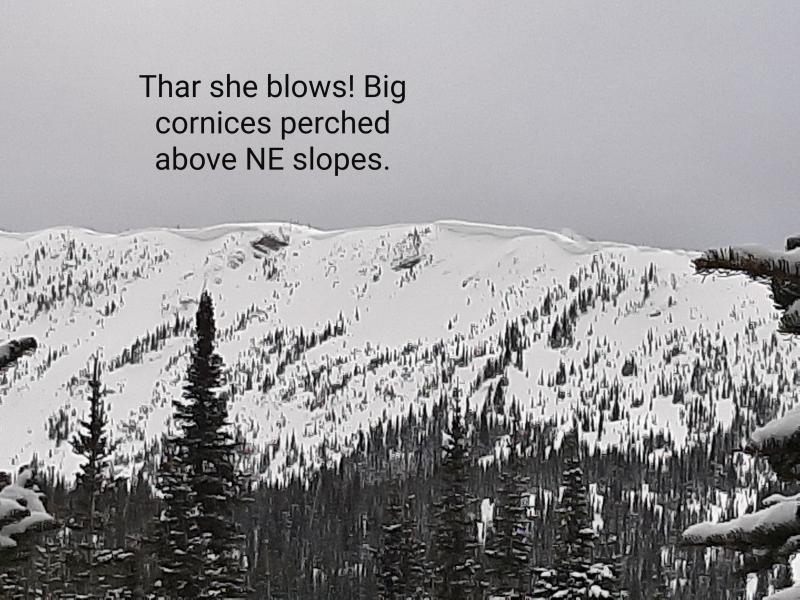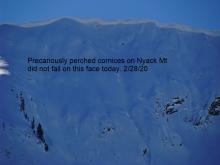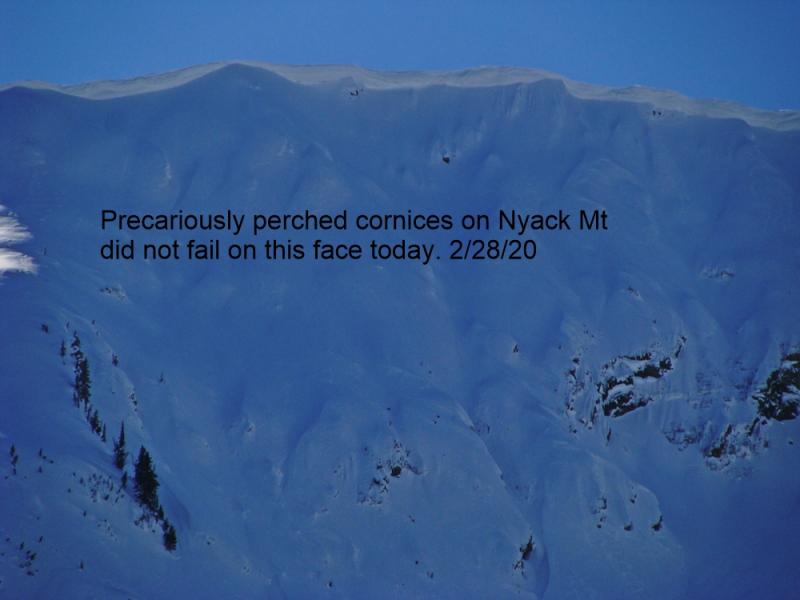| Thursday | Thursday Night | Friday | |
|---|---|---|---|
| Cloud Cover: | Lingering showers early then clearing late morning. | Cool and mostly clear. | Warming with clouds building mid-day ahead of approaching system. |
| Temperatures: | 31-46 deg. F. | 14-22 deg. F. | 31-49 deg. F. |
| Wind Direction: | West-Southwest | Southwest | South-Southwest |
| Wind Speed: | 8-10 gusts 21 | 5-6 | 8-10 gusts 20 |
| Snowfall: | 0 in. | 0 in. | 0-1 in. |
| Snow Line: |
Whitefish Range
Swan Range
Flathead Range and Glacier National Park
How to read the forecast
Cool temperatures overnight re-froze and strengthened the moist surface snow. The avalanche danger is LOW this morning, but will rise to MODERATE on sun exposed slopes above 5000 feet today. Move to a shaded area when you see the early signs of weakening surface snow like rollerballs or pinwheels forming on steep slopes. Remember that LOW danger does not mean no danger. Continue to make site specific snow pack and terrain evaluations as isolated areas of unstable snow exist.

2. Moderate
?
Above 6500 ft.
2. Moderate
?
5000-6500 ft.
1. Low
?
3500-5000 ft.
- 1. Low
- 2. Moderate
- 3. Considerable
- 4. High
- 5. Extreme
-
Type ?
-
Aspect/Elevation ?

-
Likelihood ?CertainVery LikelyLikelyPossible
 Unlikely
Unlikely -
Size ?HistoricVery LargeLargeSmall

Cool temperatures overnight re-froze yesterday's moist snow surface. The clearing skies and sun expected today will weaken this firm surface and increase the potential to trigger a loose, wet avalanche as the day progresses. Pay attention to the signs that snow is becoming weak like roller balls forming on steep slopes or sinking increasingly deeper into the snow on your skis or when you step off of your sled. Today should stay cool enough that you can simply move to a more shaded slope to manage this problem.
-
Type ?
-
Aspect/Elevation ?

-
Likelihood ?CertainVery LikelyLikelyPossible
 Unlikely
Unlikely -
Size ?HistoricVery LargeLargeSmall

Most exposed ridge lines across the advisory area harbor some beasts of cornices. Because some of these are so large and overhung its important to pay attention to what is looming above you given the sun's potential to weaken these features. Also, keep a good distance from these while traveling along ridge lines as they can pull out further back than expected, even behind the solid ground. When a large cornice falls it has the potential to trigger deep instabilities (picture a bus tumbling down a steep slope) that would otherwise remain dormant resulting in a large avalanche.
Glide cracks have been reported across the area. There is a large amount of uncertainty associated with glide avalanches, so the best way to manage them is to avoid slopes where they are present. Over the past week, we've seen the variability of spring weather in the mountains. We observed large natural avalanches last week (3/14-3/15) and Saturday (3/18) sliding on the Feb. 10 crust associated with rain at upper elevations. The Feb. 10 crust has weak sugary snow (facets) sitting on top of it in many locations and, although buried up to 4 feet deep, may continue to pose future issues. Dig into the snow to assess the recent, substantial load sitting atop the Feb. 10 crust. When we dig into our current snowpack, it tells a story of past powder days, a bit of wind, a whole lot of rain, and some clear temperature shifts. Each of these events that slowly shaped our snowpack throughout the season can come into play within one single day during the spring. Awareness of rapidly changing conditions is vital while enjoying the longer spring days in the mountains.
Wednesday: We were in Noisy/Jewel Basin in the Swan Range. The snow level in the morning was at about 6000 feet and climbed to 6500 feet as the day progressed. We found 2-3 inches of overnight snowfall that became moist mid-day. At elevations above 7000 feet an ice crust on the surface remained supportable through the afternoon. We dug a snow pit at 6800 feet on a northwest facing slope and found that recent rain and melt-water only percolated through the upper 40 cm of the snow pack. Just 500 feet below in another snow pit at 6300 feet we found wet snow all the way down to a decomposing Feb. 10 rain crust. Light wind with moderate gusts at upper elevations only drifted the overnight 2-3 inches of snow, but we noted very large cornice development from previous storms.
Tuesday: BNSF Avalanche Safety reported warm temperatures and mostly clear skies in the John F. Stevens Canyon. They found a mostly isothermal snowpack in a pit at 6350 feet on a south aspect but were able to get an ECT to propagate with moderate force about 40 cm from the surface.
Monday: FAC staff traveled to the Red Meadow area in the northern Whitefish Range. The surface snow moistened throughout the day, but no wet snow instability was observed. They also noted glide crack formation on some slopes. We also received an observation from the Southern Whitefish Range on Skookoleel Ridge that noted the snow surface was still solid at 12:00 and glide crack formation along the ridge near the cornices.
See below for all observations this season.
In the past 24 hours we picked up 2 inches of snow at most locations above 6000 feet across the advisory area. High temperatures reached the upper 30s to low 40s then dropped below freezing in most areas overnight. Currently, mountain temperatures range from 26-33º F, and winds are out of the southwest at 5-13 mph with gusts from 15-34 mph. Today, lingering showers should taper and make way for clearing skies with temperatures reaching the mid-30s. After a cool, clear night tonight clouds will re-build mid-day tomorrow ahead of another approaching system.
| 0600 temperature: | 26-33 deg. F. |
| Max. temperature in the last 24 hours: | 30-40 deg. F. |
| Average wind direction during the last 24 hours: | Southwest |
| Average wind speed during the last 24 hours: | 5-15 mph |
| Maximum wind gust in the last 24 hours: | 18-40 mph |
| New snowfall in the last 24 hours: | 2 inches |
| Total snow depth: | 84-117 inches |
This advisory applies only to backcountry areas outside established ski area boundaries. This advisory describes general avalanche conditions and local variations always occur. This advisory expires at midnight on the posted day unless otherwise noted. The information in this advisory is provided by the USDA Forest Service who is solely responsible for its content.























